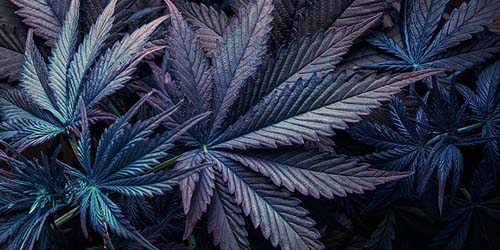
You might recognize weed by its distinctive green hand-shaped leaf with sawtooth fingers. But not every type of weed necessarily stays green. During flowering, the leaves as well as the flowers can turn blue, purple or red. Purple Haze and Blueberry are perhaps the finest examples of purple weed. In this article we explain how this happens, which strains are susceptible to such a discolouration and what it means for purple weed.
Purple Weed - What is so special about it?
From Siberia to Patagonia, weed has been found on every continent except Antarctica. But they are not all the same. Each environment has created new challenges for the weed plant. This is why fine-leaved sativas emerged in the tropics and resilient indicas. at the foot of the Himalayas. The living environment of weed plants has also changed the composition of substances in the plants. In some weed plants, at low temperatures during the flowering phase, substances are produced that also give plants such as red cabbage, blueberries and grapes their colour.
These substances are called anthocyanins - a group of powerful flavonoids that are antioxidants as well as natural pigments. In certain proportions, they colour plant material such as flowers and leaves purple, red or blue, provided that another substance leaves the plant. More on that later. Purple weed is therefore not only cool to look at. The reason why weed turns purple, blue or red has to do with the fact that they contain anthocyanins. In nature anthocyanins protect the plant, but they also allow the plant to breathe.
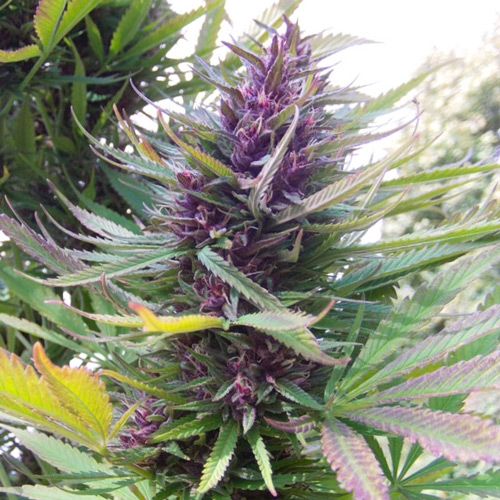
Plants are usually green because the leaves in particular contain a lot of the substance chlorophyll. Chlorophyll pigments the leaf green, has a bitter taste and helps the leaf to convert light, water and CO2 into sugars and oxygen. That process is called photosynthesis. As the temperature drops in autumn, the chlorophyll slowly breaks down in the plant. Substances such as anthocyanins then get the chance to take over.
The difference is that these substances are not green but purple. Plants need substances like chlorophyll and anthocyanins in order to convert CO2 into sugars and therefore to grow and flower. So much for the biology lesson.
How to grow Purple Weed?
In the garden it looks quite spectacular. The weed plant is already beautiful to look at. Even more so when the plant is decorated in autumn colour! Growing purple weed is simple. Take a strain that has the capacity to produce those anthocyanins. Step two is the next cultivation technique. If you introduce cold air during late flowering, your weed plants will become more colourful. This is how you do it. If you have a temperature control in your grow room, set the night temperature to 10 to 15 degrees Celsius lower than the day temperature. Gradually, the leaves and sometimes the flowers will turn purple. Which parts turn purple depends very much on the genetics of the plant.
Do you grow outdoors? Good news! Because the ground cools down more at night, outdoor weed is naturally more susceptible to discolouration than indoor weed. Some cold-footed weed varieties slowly turn purple.
Be careful with low temperatures
Be careful not to start lowering the temperature too much after reading this. Do it with care and bring the temperature down slowly but surely. Let the temperature drop to just below 10 degrees at night only. But beware. The night temperature and the day temperature should not differ by more than 15°C. This will cause stress. Stress in weed plants can have all kinds of consequences. From a reduced harvest to susceptibility to diseases, but also the spontaneous emergence of a hermaphrodite between your plants. Low temperatures can also cause a phosphorus deficiency. We will tell you more about this at the end of the article. In short: growing purple weed is not just a cold trick.
Later in this article we will take two examples to teach you how to grow purple weed with different types of weed.
Using Bud Candy
Bud Candy from Advanced Nutrients is an organic bloom stimulator. You give it as an additive to your bloom feed in order to increase the production of anthocyanins during the flowering phase, among other things. Especially when combined with the technique described above, you increase the chance of beautiful colouration. Bud Candy is available to you for under ten euros and naturally improves the taste of your weed. Give 2 ml of Bud Candy per liter of water per plant in the first to the sixth week of the flowering phase.
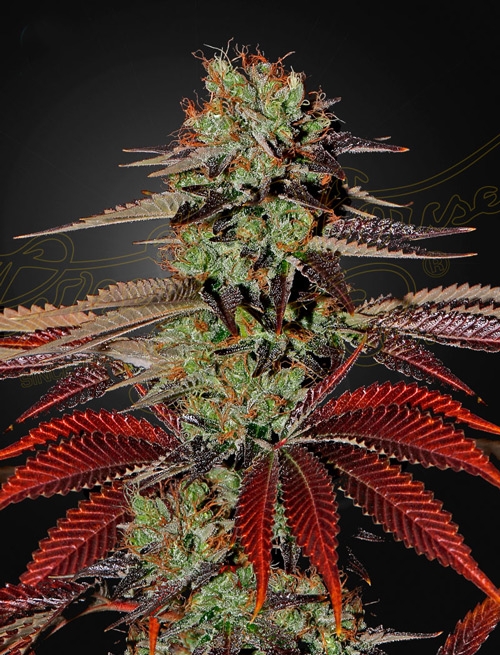
Green House Seed Company King’s Juice
List of Purple Weed Strains
Purple-coloured weed comes in all shapes and sizes. Although Purple Haze and Blueberry are the best known varieties, other varieties can also turn purple in late flowering. There are a few conditions for this. As discussed above, the low temperature during flowering is crucial, but the genetics are just as important. This means that not every variety of weed has the potential to change colour so beautifully. Disclaimer: although these strains have the genetics to turn red, purple or blue during flowering, there is no guarantee that they will do so.
- Purple Haze
- Auto Purple Punch
- Granddaddy Purple
- Grape Ape
- Mendocino Purps
- Purple Urkle
- King’s Juice
- King’s Kush Auto
- Bubba Kush
- Sour Grape
- Lavender Jones
- Shaman
- Blue Amnesia
- Purple #1
- Purple Haze #1
- Auto LSD
- Auto Purple Haze
- Blueberry
- Auto Blueberry
- CBD Auto Blackberry Kush
- Blue Dream
- Auto Blue Dream
Growing Schedule for Purple Haze Weed
We have composed this growing schedule from dozens of successful purple haze cultivations, all to be found on the popular website Growdiaries. The idea is that Purple Haze, as a sativa dominant strain, loves a warm and humid climate. That's why you keep the temperature high during the growth phase. To avoid stressing the plant too much, lower the temperature gradually until you get the night temperature below 10 °C in the last two weeks. This will cause an accelerated breakdown of chlorophyll, causing the anthocyanins in your weed to turn the buds and/or leaves purple.
|
. |
Day temperature |
Night temperature |
|
Week 1 |
24 °C |
21 °C |
|
Week 2-6 (Start of grow, 18/6*) |
27 °C |
21 °C |
|
Week 7 |
24 °C |
21 °C |
|
Week 8 (Start of flowering, 12/12**) |
24 °C |
19 °C |
|
Week 9 |
23 °C |
16 °C |
|
Week 10 - 11 |
22 °C |
12 °C |
|
Week 12 |
22 °C |
11 °C |
|
Week 13 |
21 °C |
10 °C |
|
Week 14 |
21 °C |
9 °C |
|
Week 15 |
20 °C |
8 °C |
|
Week 16 |
19 °C |
7 °C |
|
Week 17 (Harvest) |
- |
- |
* 18/6 means here: 18 hours of light and 6 hours of darkness per day. Keep this up until you switch to flowering. The first week of this schedule describes the pregrowth - that happens under a different kind of light. Some do this on a windowsill. Read more about the benefits of pre-growing weed here.
** 12/12 then means: 12 hours of light and 12 hours of darkness.
Purple Haze Effects
Purple Haze’s effects are mainly felt in your head - if you're looking for a weed that will give you an old-fashioned high, this is the one to get. A great sativa buzz awaits you after the harvest that makes you creative and social. Especially when you set the vaporizer to a lower temperature (160-170 °C).
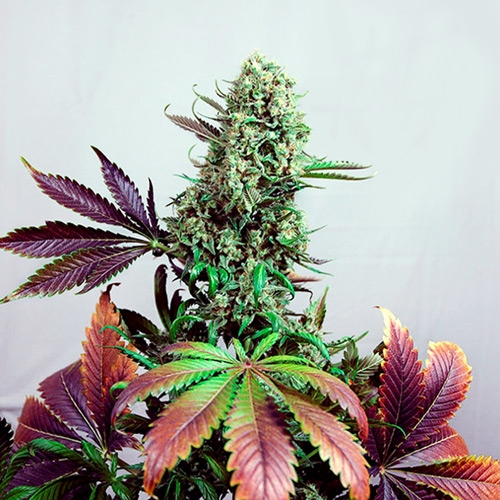
Growing Auto Blueberry Weed
A completely different type of plant that can also turn purple in the flowering phase is one of our bestsellers. Auto Blueberry is an indica-dominant strain that blooms on its own over time. We have the following temperatures from dozens of grow reports you can find on Growdiaries. In addition, we tackle the grow reports where the weed has also turned real purple. Remarkable are the temperatures that are higher here than with the most Purple Haze:
|
. |
Day temperature |
Night temperature |
|
Week 1-5 (Start of growth 20/4*) |
26 °C |
26 °C |
|
Week 6 (Clear bloom, 18/6**) |
22 °C |
18 °C |
|
Week 7 |
20 °C |
15 °C |
|
Week 8-10 |
20 °C |
10 °C |
|
Week 11-12 |
18 °C |
8 °C |
|
Week 13 (Harvest) |
- |
- |
* We see successful growing at 20 hours of light and 4 hours of darkness with many auto flowers.
** You can feel free to reduce the amount of light, but more than 14 hours of light on an auto flowering plant is fine. That will speed up flowering. By "clear bloom" we mean that you do need to see that the plant is showing clear bloom hairs before you reduce the temperature.
Auto Blueberry Effects
The effect might not be what you would expect from a plant with a lot of indica genetics. Rather than keeping you on the sofa completely stoned, Auto Blueberry gives you a positivity boost and makes you want to chill out together with your friends. It puts a smile on your face and lets you sleep wonderfully at the end of the evening. So it’s a top weed for a pleasant evening.
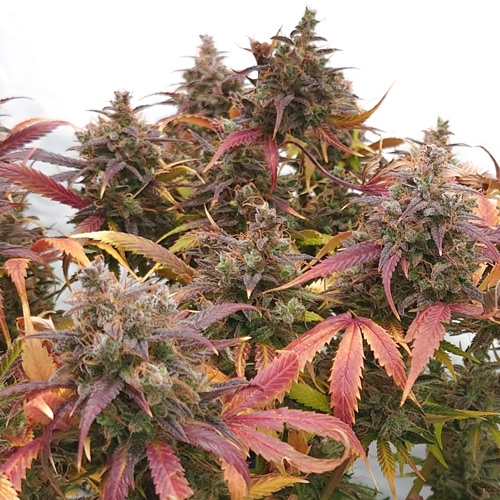
This is NOT the way to grow Purple Weed
On the internet, the craziest claims go around about growing weed. Also on this subject, the urban legends are being taken as fact. What you should definitely not do are the following tricks:
- Do not reduce the amount of oxygen, carbon dioxide or any other gas in your growing room. This has no effect on the colouring of your weed plants.
- Extra nitrogen in the feed during the flowering phase is also of no use - unless you think dry and brown looks like purple.
- Do not add colouring agents to the feed - weed plants will turn purple by themselves under the right conditions. There is no need to "dye" them.
- You can grow purple weed by depriving your plants of some nutrients. But we don't recommend this: the yield, taste, smell and effect of your weed may suffer as a result.
In short: lower the night temperature gradually during the flowering phase and above all choose the right genetics if you want your weed to turn purple, blue or red. Use the filters in our seed shop. Under "Type" choose Blue and Purple. We did not invent these very descriptive names for these weed families. They describe strains that were once crossed with the legendary strains Purple Haze or Purple Thai. Of the last-mentioned landrace, Blueberry is the most famous descendant.
Purple Stems & Phosphorus Deficit
If only the stems, branches or leaf veins of your weed plant turn purple then something else is going on. If it is not the leaf or flower but the hard parts of the plant that turn purple then this indicates a phosphorus deficiency. Besides nitrogen and potassium, phosphorus is one of the three most important substances that a (weed) plant needs to get from the soil or nutrition. Do the stems turn purple? Then there is a nutrient deficiency.
The causes of this deficiency are more complex than simply saying that you are not giving enough (bloom) nutrition. That is one of the possible causes. But the pH can also be out of balance. The acidity of the soil determines how well or poorly the nutrients can be absorbed. With purple stems, the pH value can be too high. Alkaline soils in fact suppress the absorption of this essential substance.
The stems can also turn purple when the ambient temperature drops below 20°C. This has to do with the transport of nutrients from the soil to the plant. The cold makes it harder for phosphorus to be transported to the rest of the plant. So if you do your best to follow the temperature schedules above, then it is possible that the stems will also turn purple. In the bloom phase this is no reason to panic, but that is why you must keep the temperature higher than 20°C during the growth phase.
Read more about deficiencies and surpluses in you weed plant's nutrition in this blog about leaf problems.
Sources:
- Purple Weed: How Cannabis Strains Change Colors. Amsterdam Genetics. 19 apr. 2021.
- Blauwe Familie. Dutch Passion.
- How to Grow Purple Cannabis. Royal Queen Seeds. 24 nov. 2020.